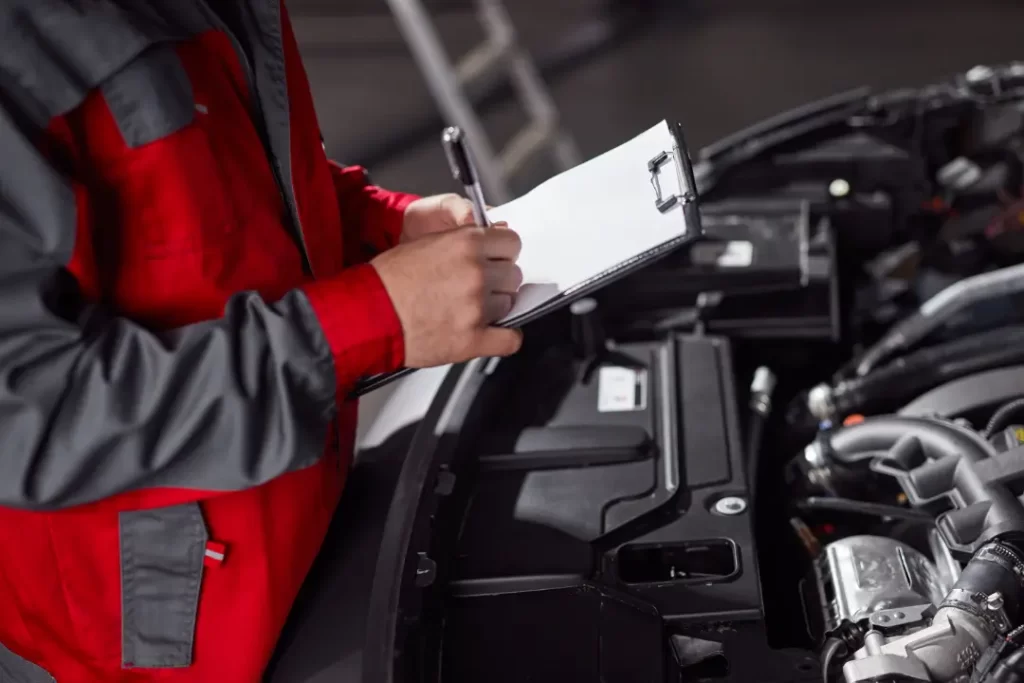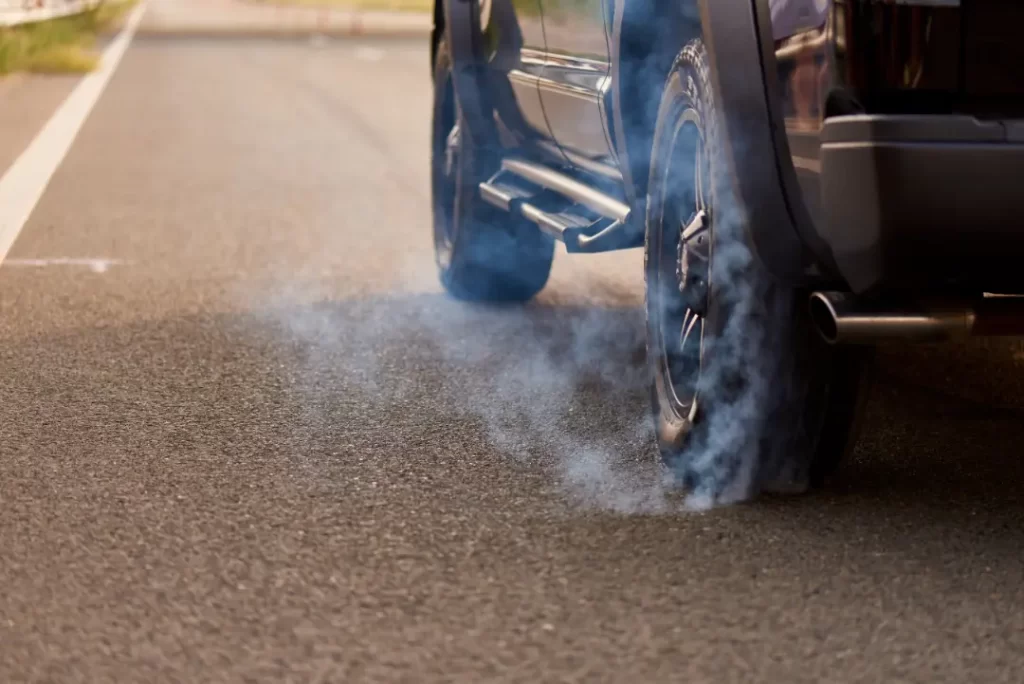Every vehicle on the road must meet strict safety and environmental standards. That is why MOT tests are so important. One key part of the process is the exhaust emission test, which checks how much pollution your car produces. But why is this test included, and what does it mean for drivers?
In this article, we will explain the purpose of the exhaust emission test, why it matters for both your car and the environment, and how it helps keep vehicles safe and comply with UK regulations.
Key Takeaways
- Exhaust emission tests are critical for ensuring vehicle compliance with environmental regulations and protecting public health by reducing harmful pollutants.
- The exhaust emission test process involves analysing pollutants emitted from vehicles, with specific procedures differing for petrol and diesel vehicles.
- Failing the emission test results in legal restrictions on driving, potential fines, and heightened environmental pollution, making proactive vehicle maintenance essential.
- Failing the emission test makes your car unroadworthy until repairs are made and a retest is passed.
- Regular maintenance, including filters, spark plugs, and catalytic converters, helps prevent MOT failures.
- Passing emissions checks protects public health, improves fuel efficiency, and ensures compliance with UK law.
- A VT30 certificate is issued for failures, restricting the legal use of the vehicle until it is retested.
The Role of Exhaust Emission Tests in MOTs
When your car goes in for its annual MOT, one of the key checks it must pass is the exhaust emissions test. This isn’t just about ticking a box for roadworthiness. It’s about protecting the air we breathe.
By measuring the level of pollutants your vehicle produces and comparing them to legal limits, the test ensures that cars on the road don’t harm the environment or public health.
Think of it as a safeguard for both people and the planet. A car that emits too many pollutants doesn’t just fail the MOT. It contributes to air pollution, undermines the UK’s climate goals, and may signal mechanical problems, such as a faulty oxygen sensor or a failing catalytic converter. Catching these issues early helps keep your emissions in check and enables your vehicle to run more efficiently.
Beyond the environmental angle, emissions testing also benefits drivers directly. It can highlight problems with the engine that might otherwise go unnoticed. This prevents breakdowns and reduces safety risks. In short, the emissions test is about much more than compliance. It’s about cleaner air, safer vehicles, and improved road performance.

What Happens During an Exhaust Emission Test?
An exhaust emission test involves a detailed analysis of the gases emitted from a vehicle’s exhaust pipe. The process includes :
- Placing a probe into the vehicle’s exhaust pipe to sample the emitted gases.
- Measuring the primary pollutants, which include carbon monoxide, hydrocarbons, particulate matter, and smoke opacity.
- Comparing these readings against legal limits to determine if the vehicle’s emissions are within acceptable levels.
The specifics of the test can vary depending on whether the vehicle is powered by petrol or diesel. The processes for both petrol and diesel vehicles will now be explored, highlighting the key differences and what vehicle owners can expect during the test.
Petrol Vehicles
For petrol cars, the exhaust emissions test focuses on four main gases: carbon monoxide, hydrocarbons, oxygen, and carbon dioxide. These measurements are taken twice, once at normal idle and again at higher engine speeds, to provide a clear picture of how cleanly the engine is running. At idle, for example, carbon monoxide levels must stay below 0.3 percent. If the vehicle was not originally made with a catalytic converter, slightly higher limits apply.
Why focus on carbon monoxide? This gas is one of the most harmful pollutants produced by petrol engines. Keeping it within legal limits helps protect both drivers and the environment.
If a vehicle fails the test, the examiner will check if a catalytic converter was originally installed, as this affects which standards apply.
A failed emissions test usually indicates underlying issues, such as a faulty catalytic converter or engine problems. While frustrating, these results are actually helpful. They point out problems that, once resolved, not only help the car pass the retest but also improve fuel efficiency and overall performance.
In other words, the emissions check is just as much about your car’s health as it is about meeting legal requirements.
Diesel Vehicles
During an MOT, diesel vehicles undergo a smoke opacity test, rather than measuring gases like petrol engines do. The process involves inserting a probe into the exhaust and revving the engine several times from idle to its maximum speed.
The testing equipment measures the density of the exhaust smoke and compares it to the vehicle’s legal limit, which is usually on its VIN plate.
A diesel vehicle fails the test if the smoke opacity exceeds the allowed level, if it produces excessive visible smoke, or if emissions equipment, such as a Diesel Particulate Filter (DPF), is missing or not functioning properly.
This ensures that the vehicle does not contribute to harmful pollution and that its emissions control systems function correctly.
Importance of Passing the Exhaust Emission Test
Passing the exhaust emission test is mandatory in the UK, ensuring compliance with legal environmental standards. Compliance is crucial for both the legal roadworthiness of a vehicle and the broader goal of environmental protection.
Vehicles that pass the emissions test contribute less to air pollution, helping to protect public health by reducing the risk of respiratory and cardiovascular diseases.
Regular emissions testing can improve fuel efficiency. Addressing issues like faulty oxygen sensors or worn catalytic converters during these tests enhances vehicle performance and reduces fuel consumption.
Well-maintained vehicles not only produce fewer emissions but also run more efficiently, thereby supporting environmental regulations and initiatives.
Proactive emissions testing helps avoid costly repairs by identifying potential problems early on. This ensures compliance with environmental regulations and supports broader goals by reducing overall vehicle pollution.
Consequences of Failing the Emission Test
Failing the exhaust emission test leads to significant consequences:
- Legally, a vehicle that fails an MOT test cannot be driven except to a pre-booked appointment for repairs or retesting.
- Failing the test can disrupt your daily routine and necessitate immediate action to rectify the issues.
- It can result in fines if you are caught driving without a valid MOT certificate.
- It may lead to the invalidation of insurance.
- It can cause complications with vehicle registration renewal.
A vehicle that fails the emission test must therefore undergo repairs to address identified issues. This process can be time-consuming, as it requires finding a reliable mechanic and scheduling the necessary repairs before retesting.
During this period, you will receive a VT30 refusal of an MOT test certificate, indicating that your vehicle fails to be roadworthy until it passes the retest.
High exhaust emissions significantly contribute to poor air quality and the pollution produced by environmental impact degradation. Pollutants like nitrogen oxides can cause respiratory issues and other human health problems, underscoring the importance of keeping your vehicle’s emissions within legal limits.
Tips to Ensure Your Vehicle Passes the Emission Test
Several proactive steps can help ensure your vehicle passes the exhaust emission test:
- Ensure your vehicle has sufficient oil and fuel for the test.
- A pre-emission treatment can effectively lower harmful emissions before the test.
- Replacing worn spark plugs can improve combustion efficiency and reduce emissions.
Maintaining your vehicle’s air and fuel filters is crucial:
- Cleaning or replacing these air filters enhances engine performance and reduces pollutants. Maintaining your catalytic converter is essential for controlling emissions.
Addressing oxygen sensor issues helps:
- Maintain the correct air-fuel ratio
- Decrease emissions
- Improve fuel efficiency.
- It is also important to replace air filters regularly.
Following these tips and conducting regular maintenance helps identify and rectify mechanical problems before they escalate.

How Ivydene Garage Ltd. Can Help with Your MOT
Ivydene Garage Ltd. is a family-run business based in Ashford, Kent, operational since 1981. Recognised by Bosch as a centre of excellence for over 32 years, our garage combines decades of experience with Bosch Car Service accreditation. Our expertise ensures your vehicle receives the best possible care.
Our garage offers a range of services, including:
- MOT Testing (Class 4) for cars, light vans, and motor caravans up to 3 tonnes
- Maintenance
- Diagnostics
- Repairs
We provide a convenient one-stop solution for motorists in Ashford and neighbouring areas. Whether it’s ensuring your vehicle passes the MOT emissions test or addressing any underlying issues, Ivydene Garage Ltd. has you covered. Book with us today.
Frequently Asked Questions
What happens if my vehicle fails the exhaust emission test?
If your vehicle fails the exhaust emission test, it cannot be legally driven until it passes a retest, and you will receive a VT30 certificate stating that it is not roadworthy. You must arrange for repairs and a retest to legally use the vehicle again.
How can I ensure my vehicle passes the emission test?
To ensure your vehicle passes the emission test, prioritise regular maintenance by checking oil and fuel levels, replacing worn spark plugs and filters, and ensuring the catalytic converter and oxygen sensor are functioning properly.
Consider using a pre-emission treatment to reduce harmful emissions before the test.
Why are exhaust emission tests important?
Exhaust emission tests are essential for minimising vehicle pollution and improving air quality, directly protecting public health.
They also ensure compliance with legal standards and help detect mechanical problems that may elevate emissions.
What specific pollutants are measured during an exhaust emission test?
During an exhaust emission test, petrol vehicles are assessed for carbon monoxide, hydrocarbons, oxygen, and carbon dioxide, while diesel vehicles are primarily tested for smoke opacity and particulate matter.
How can Ivydene Garage Ltd. help with my MOT?
Ivydene Garage Ltd. can assist you with your MOT through comprehensive Class 4 testing and additional car services such as maintenance and repairs, ensuring your vehicle meets all standards and remains in optimal condition. Our experienced team is accredited by Bosch Car Service, providing you with reliable and professional support.
Conclusion
The exhaust emission test is a vital component of the MOT test, ensuring that vehicles meet legal environmental standards and contribute to public health and safety.
By understanding the process and importance of these tests, vehicle owners can take proactive steps to maintain their vehicles’ emissions within acceptable limits.
Ensuring your vehicle passes the emissions test not only keeps you compliant with legal standards but also supports broader environmental goals.
For comprehensive MOT testing and vehicle maintenance, Ivydene Garage Ltd. offers the expertise and services you need to keep your vehicle running efficiently and safely.
